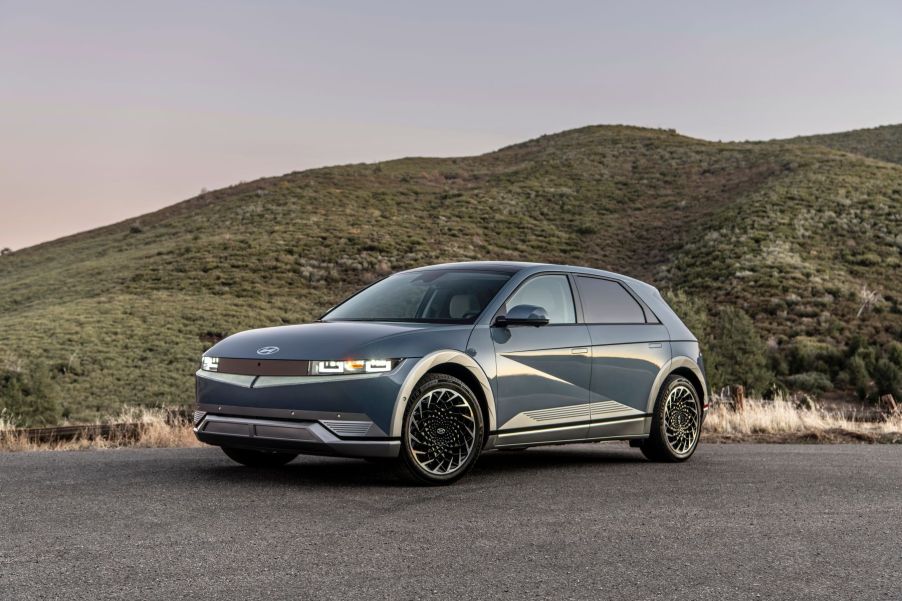
4 Reasons to Buy a 2022 Hyundai Ioniq 5, Not a Kia EV6
The Hyundai Ioniq 5 is one of the latest entrants into the electric SUV market, and by the looks of it, the BEV has a lot of things going for it. Notably, it’s being marketed as one of the more affordable EV models available, and the manufacturer also aims for the vehicle to be a major player in the EV field. So, can it handle the competition? Here are four reasons to pick the 2022 Hyundai Ioniq 5 over one of its big rivals, the 2022 Kia EV6.
1. More power in the lowest trim

The lowest trim levels for the 2022 Hyundai Ioniq 5 and 2022 Kia EV6 are the SE trim and Light trim, respectively. According to Edmunds, the power output for the motor in the Ioniq 5’s SE trim is 225 horsepower. Conversely, the Kia EV6’s Light trim option has a maximum power output of 167 horsepower. As for the torque, both vehicles are equal at 258 lb-ft.
This difference in power is a bit costly for the EV6, especially where the acceleration is concerned, with Inside EVs mentioning that dashing from 0 to 60 mph takes about 8.0 seconds. Conversely, it takes the Ioniq 5’s SE trim 7.4 seconds to achieve the same acceleration.
That said, the higher trims of the Kia offer comparable levels of power to the Ioniq 5, resulting in relatively similar performance. In fact, Kia clocks the top-of-the-line EV6’s acceleration at 4.6 seconds, while Consumer Reports asserts the Ioniq 5 is only slower by 0.1 seconds when going from 0 to 60 mph. However, you’ll have to spend more to reach that arena of power.
2. The extra driving range of the Ioniq 5
Another reason why you should pick the Hyundai Ioniq 5 over the 2022 Kia EV6 is the extra driving range, especially if you’re going for the lowest trim level. According to Hyundai, the RWD version of the Ioniq 5 SE trim comes with a 303-mile all-electric range. By comparison, the EV6’s light trim, which is only available with an RWD drivetrain, offers a 232-mile range, giving the edge to the competition.
However, higher trims seem to flip the script. The Hyundai SUV maintains the same 303-mile range for the SEL and Limited trims. Conversely, the two higher trims of the Kia EV6, the Wind and GT-Line options, raise the electric driving range to 310 miles.
This disparity only grows wider for the all-wheel drive options that sacrifice some of the range for more power. The AWD versions of the Ioniq 5 have a maximum range of 256 miles, while similar drivetrain models of the Kia EV6 have a 274-mile range.
Ultimately, if you only have the budget for a lower-trim option, the Hyundai is a much better pick.
3. Plenty of interior space
The Kia EV6 may be longer, but that’s the only area where it’s bigger than its competition. Hyundai’s electric vehicle is 0.4 inches wider, 2.2 inches taller, and even has a longer wheelbase. This translates into a larger cabin, with the Hyundai SUV having 133.7 cu. ft. of EPA interior volume while the cabin in the EV6 is 127.4 cu. ft.
This may be why Consumer Reports describes the interior as generously spaced with enough legroom. While the website has yet to test and give its verdict on the EV6‘s interior, more space is always better, especially for taller individuals. It allows for sufficient legroom, headroom, and knee room to ensure passengers remain comfortable.
4. The Hyundai Ioniq 5’s cargo space
The extra inches in the height and width of the Hyundai Ioniq 5 compared to the Kia EV6 also come into play where the cargo space is concerned. Kia’s offering features 24.4 cu. ft. in its standard configuration, where all the seats are up. This space is increased to 50.2 cu. ft. once the user folds the seats.
The Ioniq 5’s cargo space, on the other hand, is 27.2 cu. ft. in its default configuration, although it can be expanded to 60.2 cu. ft., edging out its respectable EV competitor.


